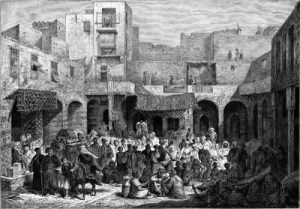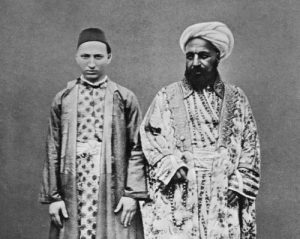Slavery, people living today may not like to hear that word, especially when they see the slavery practices that ISIS carried out against Yazidi women some time ago. However, don’t be surprised if this practice was common in the past, although there are fairly stark differences in practice.
Slavery is one of the oldest institutions in human history (Philips, 1993: 157; Toledano, 1997: 3; Malekian, 2011: 225). Not only one of the oldest, but also the most widespread. Slaves existed in almost every ancient civilization, from Sumer to Babylon to Egypt.
Despite its long history, slavery remains a secondary issue that is rarely studied. There is also a study of slavery, often dominated by plantation slavery in the New World, particularly the Caribbean, Brazil, and the United States.
In the history of Islam, there are very few studies on slavery. In fact, the issue is often considered a sensitive one by Muslim historians. Therefore, slavery has never been part of the glorious Islamic historical tradition.
Slavery in the Middle East
Slavery has a long history in the ancient Middle East. Ancient written records of the Sumerians, Babylonians, Egyptians and other ancient peoples bear this out.
In ancient times, slaves were mostly owned by kings, religious figures and other great people, and a few were privately owned. Often, they came from prisoners of war and were later used to cultivate fields and tend royal herds.
Interestingly, slavery still exists despite the emergence of divine religions in the Middle East. The three divine religions (Judaism, Christianity, Islam), accept and acknowledge the existence of slavery (Lewis, 1990).
By the time the Prophet Muhammad began spreading Islam in the 7th century, slavery in Arabia had become a deeply ingrained and widely accepted institution. In fact, at that time Arabia and Egypt were the terminus of the slave trade route, which originated in Sudan and Somalia. It is therefore not surprising that Muhammad accepted and saw slavery as an inseparable part of the existing complex social structure (Hamel, 2013:18).

When considering slavery, the Prophet took a reformist rather than a revolutionary approach. He did not intend to completely abolish slavery anytime soon. Instead, her goal was to improve the lives of slaves by treating them humanely.
The Prophet’s attitude towards slavery was re-emphasized during Hajj and Da, when he ordered slaves to receive food and clothing while their masters were fed and clothed. When masters could not take care of their slaves, they had to free their slaves (Gordon, 1989:19).
Given the long roots of slavery in the Middle East, the lack of a more radical approach to abolition was understandable at the time. In Arabia itself, slaves have become one of the main engines of the Arab economy and part of social life. The abolition of slavery certainly had a major impact on society, and it was not impossible to create chaos.
Ultimately, in the absence of a movement to abolish slavery, the institution continued to grow in the Islamic era.
According to Islamic law, there are two ways to enslave others. The first is from jihad or holy war, and the second is from descendants of slave parents. So when a slave couple had a child, the child automatically became a slave. These two methods were used to ensure that only non-Muslims were enslaved (Gordon, 1989: 24).
Jihad became one of the main philosophies during the great religious expansion of Islam in the first century. During this period, many areas were silent, but on the other hand, the unanswered question also remained, in all these expansions, was the sacred purpose of jihad still the main motive, or did the motive of collecting loot and slaves predominate? This question became the basis for wider research, especially during the period of Islamic expansion after the death of the Prophet.
The Development of the Slave System
Over time, slaves were obtained not only through these two methods, but also through buying and selling. This activity did not violate the Qur’an and was initiated by the first Umayyad caliph, Mu’awiyah. Since then, the sale of slaves in the Islamic world has increased.
In this buying and selling, there is a price for slaves that is determined in terms of sex. Castrated men cost the most, followed by young and white women.
Islam prohibits slave owners from exploiting female slaves and forcing them to become prostitutes. This is a major reform because slavery and prostitution were common in the pre-Islamic Middle East. Still, Islam made concessions to employers by allowing them to have sex with slaves (Milk al-yamin) (Ali, 2010:164).
As concubines, they enjoyed the privilege of better food and clothing. They are also exempted from housework, so their only job is to serve their Lord (Ali, 2006:40).
These female slaves were not only used as concubines, these female slaves were also used as gifts for the rulers of the Islamic dynasty at that time. Giving gifts in the form of slaves was considered part of the diplomatic process.
An example of the use of slaves as a diplomatic gift is the practice of Musa ibn Nusayr, the governor of Ifricia. He also helped capture some 300,000 Berbers while capturing the remainder of the Berber tribes in North Africa. Of this staggering number of captives, some were recruited into the army, some female slaves were given to rulers of Egypt and Damascus, and the rest were sold (Hamel, 2013:115).
Slavery seems difficult to separate from the development of Islamic civilization, because when Islam entered its golden age, slavery was still one of the important elements in people’s lives.

The classification of slaves appeared during this period, namely black slaves (abd) and white slaves (mamluk and kuls). The advent of this color classification also led to differences in the duties of individual slaves (Lewis, 1990).
Black slaves were generally assigned to peasant and domestic affairs, while Mamluk slaves and Kurds were assigned to military and administrative positions. The Turks were popular as military slaves because they could shoot arrows, ride well, and were loyal to their masters.
In addition to loyalty, military slaves enable rulers to increase control over a region and weaken the power base of local elites that may threaten central power (Chaney, 2012: 366).
With the advent of this color-based class of slaves, they were treated differently. In practice, white slaves enjoyed greater freedom than black slaves. If they performed well, they could gain higher social status, while black slaves had more limited opportunities. It is therefore not surprising that post-Umayyad historical records rarely find black slaves occupying strategic positions around palaces (Lewis, 1990).
This classification also eventually gave rise to several slave dynasties, one of which was the Mamluks of Egypt. The dynasty was ruled by slaves who had served in the military and administration.
Bibliography
Ali, Kecia. Sexual Ethics and Islam Feminist Reflections on Qur’an, Hadith, and Jurisprudence. Oxford: One World, 2006.
Ali, Kecia. Marriage and Slavery in Early Islam. Cambridge: Harvard University Press, 2010.
Chaney, Eric; George A. Akerlof; dan Lisa Blaydes. “Democratic Change in the Arab World, Past and Present”. Brookings Papers on Economic Activity, 2012.
Gordon, Murray. Slavery in The Arab World. New York: New Amsterdam Books, 1989.
Hamel, Chouki El. Black Morocco: A History of Slavery, Race, and Islam. Cambridge: Cambridge University Press, 2013.
Lewis, Bernard. Race and Slavery in the Middle East: an Historical Enquiry. Oxford: Oxford University Press, 1990.
Malekian, Farhad. Principles of Islamic International Criminal Law. Leiden: Brill, 2011.
Philips, John Edward. “Some Recent Thinking on Slavery in Islamic Africa and the Middle East”. Middle East Studies Association Bulletin, Vol. 27, No. 2, 1993.
Toledano, Ehud R. Slavery and Abolition in the Ottoman Middle East. Seattle: University of Washington Press, 1998.